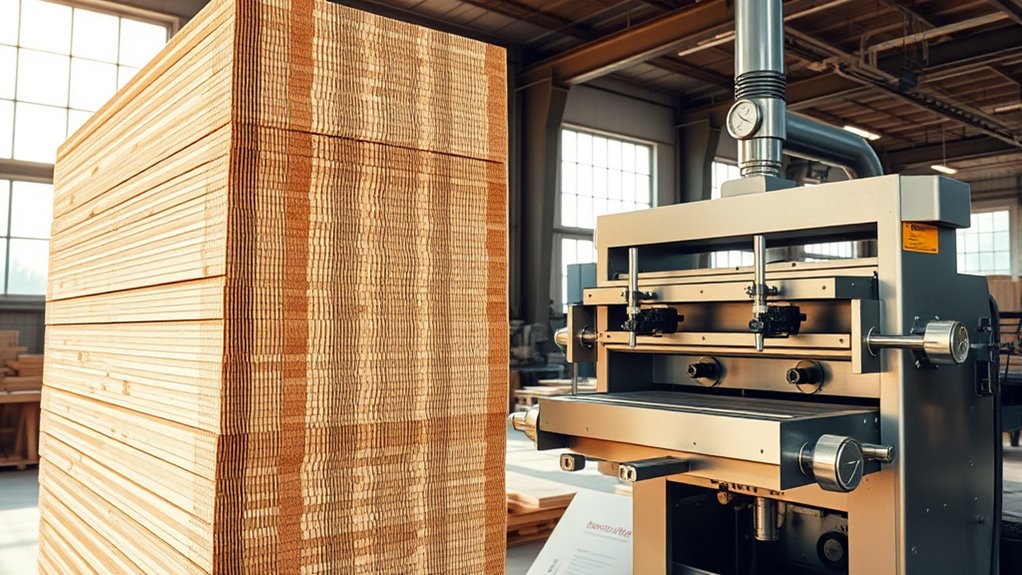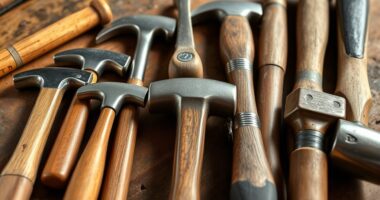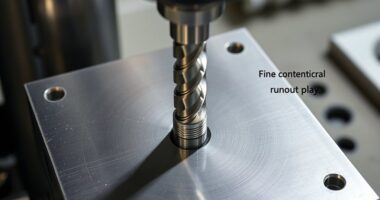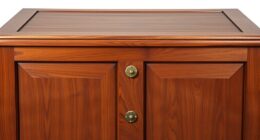Understanding cross-laminated timber (CLT) involves knowing how layers of timber are stacked perpendicularly and bonded with specialized adhesives, creating a strong, durable panel for construction. Laminating presses play a vital role by applying even pressure and heat during the curing process, ensuring the adhesive bonds perfectly. This precise process guarantees the panels’ stability and strength. If you want to learn more about how these components work together to produce high-quality CLT, keep exploring further.
Key Takeaways
- Cross-Laminated Timber (CLT) is made by stacking timber layers in perpendicular directions for enhanced strength.
- The lamination process involves precise adhesive application and layering to ensure durable bonds.
- Laminating presses apply uniform heat and pressure to cure adhesives and bond layers securely.
- Proper pressing eliminates air pockets and ensures consistent adhesion, critical for structural integrity.
- Quality control after pressing guarantees panels meet safety standards and are suitable for load-bearing construction.

Have you ever wondered how massive, strong wooden panels are made for innovative construction? The process begins with understanding how wood bonding plays a critical role in creating durable, reliable cross-laminated timber (CLT). Essentially, CLT panels are built by stacking layers of timber in a perpendicular arrangement and bonding them together to form a solid, engineered wood product. This technique allows for the creation of large-format panels that can support significant loads, making them ideal for floors, walls, and roofs in modern building projects. The key to this process is the manufacturing process that guarantees each layer adheres perfectly, providing stability and strength.
Cross-laminated timber panels are engineered by stacking and bonding perpendicular layers of wood for strength and stability.
The manufacturing process for CLT starts with selecting high-quality timber, which is then cut into planks of precise dimensions. These planks are dried to ideal moisture levels to prevent warping or shrinking over time. Once prepared, the layers are arranged in a crosswise pattern—each layer perpendicular to the one below it—to maximize strength and stability. This cross-laminated structure distributes loads evenly and enhances the panel’s resistance to warping, cracking, and splitting. The core step in creating these panels involves the application of adhesives, which are specially formulated for wood bonding. These adhesives ensure a strong, lasting bond between layers, crucial for the structural integrity of the finished product. Additionally, the quality and type of laminating presses used can significantly influence the final strength and durability of the panels.
The next stage in the manufacturing process involves pressing the layers together using laminating presses. These presses apply uniform pressure and controlled heat, ensuring that the adhesive cures properly and that the layers bond seamlessly. During this pressing stage, pressure is maintained for a specific duration to facilitate ideal adhesion and to eliminate any air pockets that could weaken the panel. The laminating presses are equipped with advanced controls to regulate temperature and pressure, guaranteeing consistency across each panel produced. Once pressed, the panels are cooled, trimmed, and inspected to meet strict quality standards before they’re ready for delivery and construction use.
This entire process hinges on precise control of each step—from wood bonding to the use of laminating presses—ensuring that each panel is strong, dependable, and capable of supporting modern architectural designs. Understanding these manufacturing processes reveals how innovative engineering and craftsmanship transform raw timber into massive, robust panels suitable for a variety of structural applications. It’s this combination of advanced technology and skilled workmanship that allows cross-laminated timber to stand out as a sustainable, versatile building material for the future.
Frequently Asked Questions
What Are the Environmental Benefits of Using Cross-Laminated Timber?
Using cross-laminated timber benefits the environment because it promotes sustainable forestry, reducing deforestation and conserving forests. It also helps with carbon sequestration, as trees absorb CO2 from the atmosphere and store it in the wood. By choosing CLT, you support eco-friendly building practices, lower greenhouse gas emissions, and create a more sustainable future for our planet. Your choice makes a positive impact on the environment and promotes responsible resource use.
How Does Moisture Affect the Lamination Process?
Moisture is like an unwelcome guest at a party, causing chaos in the lamination process. When moisture content is high, it hampers wood bonding, leading to weak joints or delamination. Excess moisture can cause uneven pressing and compromised structural integrity. To guarantee a strong bond, you need to control moisture levels, keep wood properly dried, and maintain ideal conditions for the lamination process to succeed.
Can Laminating Presses Be Used for Materials Other Than Wood?
Yes, laminating presses can be used for alternative materials beyond wood. Their press versatility allows you to bond materials like plastics, composites, and even fabrics. You just need to adjust the temperature, pressure, and pressing time accordingly. This flexibility makes them ideal for diverse manufacturing processes, helping you create strong, durable laminated products across various industries. Always guarantee you select the right settings for each specific material to achieve the best results.
What Are the Safety Precautions When Operating a Laminating Press?
When operating a laminating press, you should always guarantee proper safety precautions. Use machine guarding to protect your hands and face from moving parts or hot surfaces, and stay alert to avoid accidents. Familiarize yourself with the emergency shutdown procedures before starting, so you can quickly stop the machine if needed. Wearing protective gear and maintaining a clean workspace also help prevent injuries and ensure safe operation.
How Long Does It Typically Take to Produce a Cross-Laminated Timber Panel?
Ever wonder how long it takes to produce a cross-laminated timber panel? Typically, the manufacturing timeline ranges from several hours to a couple of days, depending on the size and complexity. Your production efficiency plays a vital role—optimized processes can speed this up without sacrificing quality. Usually, the actual lamination process takes around 2-4 hours, but curing and finishing might extend the total production time.
Conclusion
Now that you understand how cross-laminated timber and laminating presses work, you can appreciate their role in sustainable construction. Did you know that CLT production reduces carbon emissions by up to 50% compared to traditional steel and concrete? This shows how adopting these innovative materials and techniques not only strengthens your projects but also helps protect the environment. Embracing this technology can make a significant impact on building greener, more efficient structures for the future.









